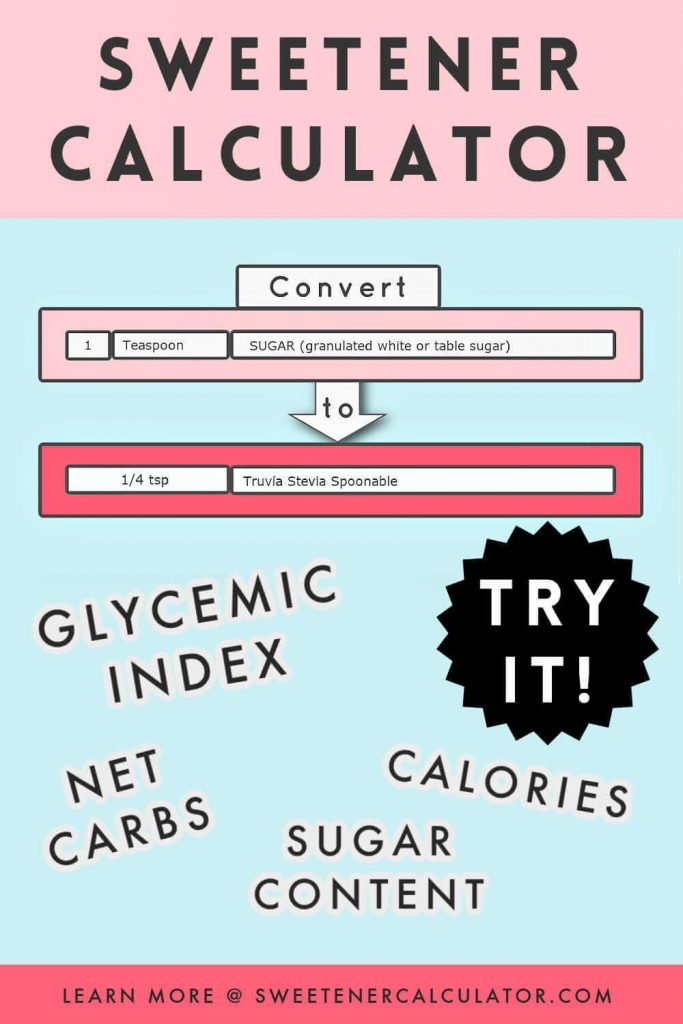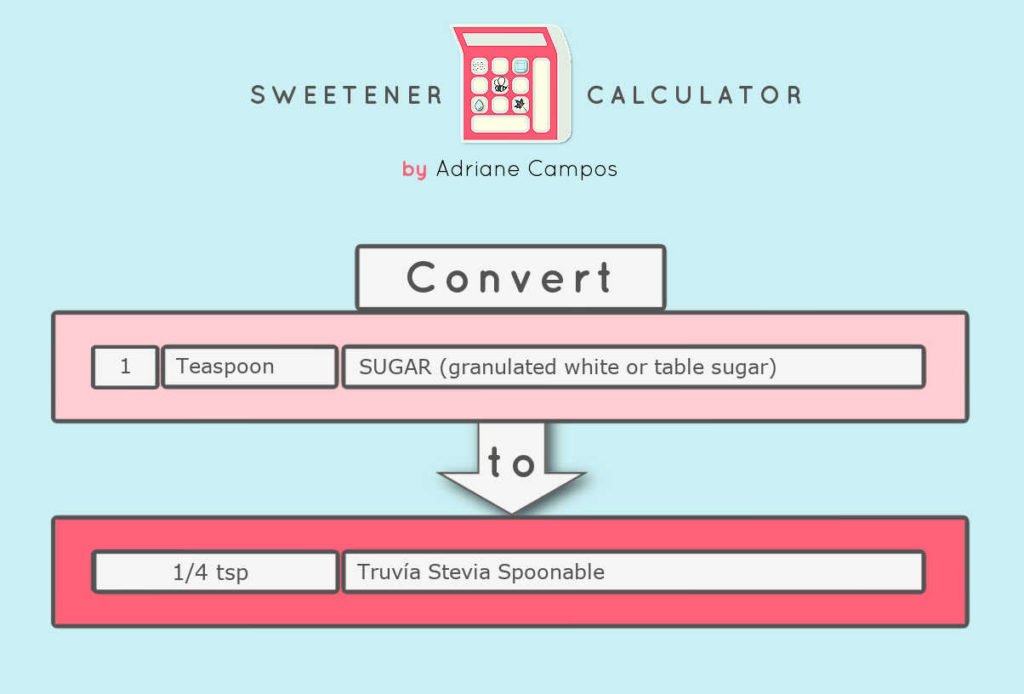Are measurements your biggest frustration when swapping sweeteners in your recipes? If you’re looking for an easy way to convert sugars, syrups, and alternatives, you need this Sweetener Calculator.
There are several reasons why you might want to substitute a sweetener in your coffee, dessert, and baking.
You want to eat healthier, have less sugar, or no sugar at all. You follow a specific diet to help you lose or maintain weight, such as the low-carb ketogenic. Or you used all of that sweetener on your favorite body scrub.
Okay. Now, you’re ready to substitute one sweetener for another, but when it’s time to measure it, a cascade of questions. What is the ratio you need to use? Should you add more or less than the sweetener called for in the recipe?
In other words, how do you convert one sweetener to another?
Sweeteners tend to taste and behave differently, so finding the right measurements can be tricky.
Confused and overwhelmed by all the sweeteners in stores?
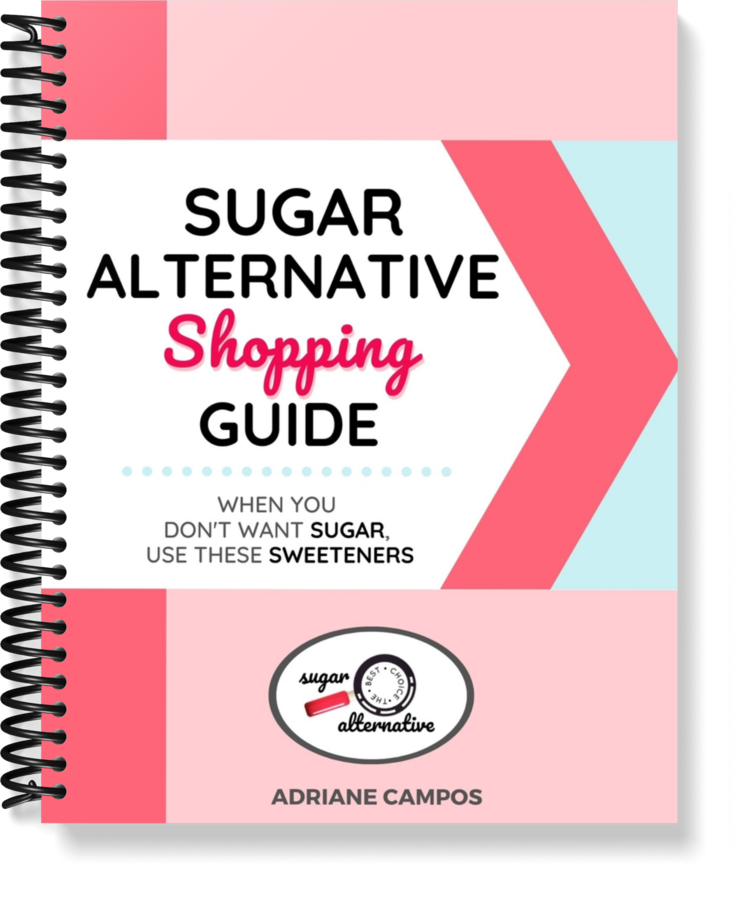 With 1000s of products sold in stores, our Sugar Alternative Shopping Guide will help you make sense of ALL the different options. It’s a goldmine—get it free for a limited time!
With 1000s of products sold in stores, our Sugar Alternative Shopping Guide will help you make sense of ALL the different options. It’s a goldmine—get it free for a limited time!
To help you find out the sweetness level of 1000s of sweeteners, I created a Sweetener Calculator. It offers an easy way to convert one sweetener to another, and I’ll tell you why and how to use it.
How sweet is your sweetener?
The first thing you need to know before venturing into sugar alternatives is that they offer different sweetness levels. Not all of them measures cup-for-cup, just like table sugar. And that makes it easy to get confused and have your recipes flop.
So, to substitute one sweetener for another, you have to find out how much to use — a volume or weight that will give you an equivalent sweetness level. It would be easier if the ratio were always 1:1 with sugar, but it’s not. You might have to add less and more than table sugar.
When shopping, you’ll have the option to buy three sugar replacements:
1. Sweetener is “as sweet as table sugar”
The easiest way to replace table sugar is by looking for a one-to-one sugar replacement. Also called cup-for-cup or spoon-for-spoon sugar substitute, it measures just like sugar. You simply exchange table sugar in your recipe with an equal volume (not weight) of the alternative. For example, coconut sugar, maple syrup, and almost 100 zero-calorie sweeteners are 1:1 sugar replacements.
2. Sweetener is “sweeter than table sugar”
Some sweeteners are 2, 5, or 100 times sweeter (in volume) than table sugar, which means that you will need to use less of them to get the same sweetness level as table sugar. For example, honey is about 30% sweeter than table sugar. You can replace each cup of sugar with 2/3 cups of honey. And then, there are those super sweet products, such as pure stevia leaf extracts—just 1/64 to 1/96 of a teaspoon of pure stevia is equivalent to one teaspoon of table sugar.
3. Sweetener is “less sweet than table sugar”
Sweeteners such as erythritol and allulose are 30 percent less sweet than sugar, which means you need to use more of them to get the same sweetness level. To replace each cup of sugar in your recipe, add 1 1/3 cup of allulose or erythritol.
Bottom line: If a sweetener is as sweet as table sugar, you use the same amount. If sweeter, use less. If less sweet, use more.
What’s the ratio sweetener to sugar?
If you’re thinking, how do I find the sweetness level of a sweetener? how much more or less than table sugar will I need?
Typically, you would have to search the product’s label or website for a conversion chart. And that’s what I did when I first started my sweetener endeavors. I saved a bunch of conversion charts by looking into the sweetener front and back of the package. If I couldn’t find it, I’d go to the product’s website or I contacted sellers.
I started by putting together a chart, like the one you see below, for common stevia sweeteners. Over time I had a gigantic conversion chart with 100s of sweeteners.
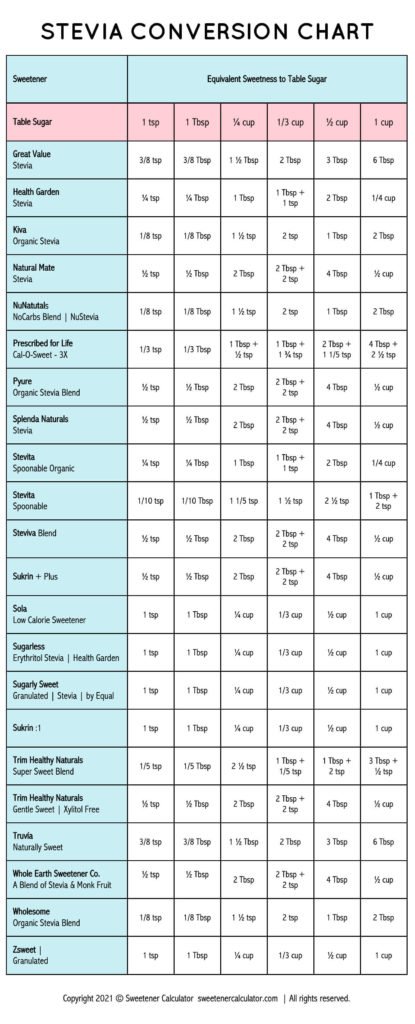
Here are the problems I see with conversion charts.
If you look at the row highlighted in pink, table sugar is always the reference. It means that manufacturers compare the sweetness level of their product to table sugar. This is only useful if you have a recipe with table sugar.

What if your recipe calls for a different sweetener, which is not table sugar? For example, your recipe is with Truvía Spoonable, but your grocery store only carries Pyure Stevia Blend, so you decide to try that instead. It means that you will be forced to do the math to convert Truvía, which is almost 3x sweetener than sugar, to Pyure (twice as sweet as sugar).
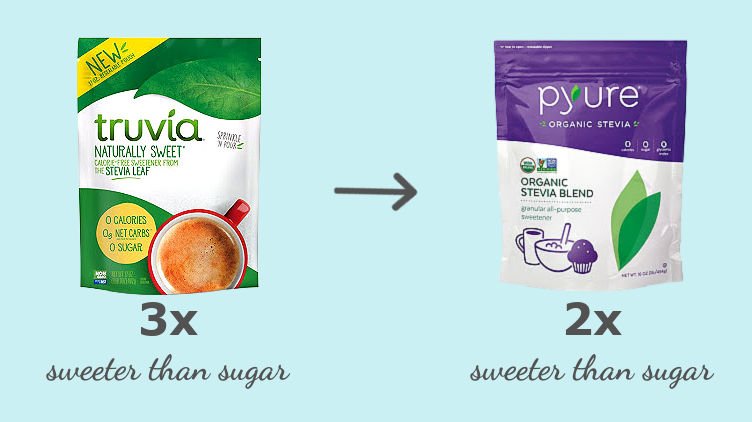
Another problem is conversion charts usually list the equivalent sweetness to one teaspoon, one tablespoon, ¼ cup, 1/3 cup, ½ cup, and 1 cup of table sugar. However, we all have recipes that call for different sugar amounts. And, again, you’ll have to do the math yourself.
That’s why I created a calculator. My Sweetener Calculator will help you out in any case of substitution. Just enter the amount of one sweetener in the calculator, and it will give you how much of another has the same sweetness level.
How to use the sweetener calculator?
Now you know that, for you to replace one sweetener with another, you will need to measure an amount (volume or weight) with an equivalent sweetness level. And the Sweetener Calculator does it for you.
Here is how.
The calculator lets you convert volumes — teaspoon, tablespoon, cup, packet, stick, cube, tablet, drop, squeeze, milliliter, fluid ounce — or weight in grams, ounces, pounds. Just follow the steps below:
- Enter the amount to convert from (ex: recipe calls for 1 cup)
- Select the sweetener to convert from (ex: recipe calls for table sugar)
- Decide the sweetener to convert to (ex: you have Splenda Stevia)
- Find your result (ex: measure ½ cup of Splenda Stevia).
And the calculator does even more, but that’s for another post. Spoiler alert: it compares sweeteners side by side based on their calories, net carbs, glycemic index, and sugar content. Also, it gives you their ingredients and related products. Sweet!
Because converting the amount to use is only the beginning, I wrote a list of tips to help you in your baking endeavors. Explore them on my blog.
Measure and weigh sweeteners (the right way)
After getting the result from the Sweetener Calculator, measure and weigh sweeteners carefully. Here is what you need to know to swap the right amount.
Measuring volume of sweeteners
To measure cups, tablespoons (Tbsp), teaspoons (tsp), milliliters (mL), fluid ounces (fl oz), you’ll need three sets of measuring tools—measuring spoons, dry measuring cups, and liquid measuring cups:
- Measuring spoons — Even though they were made for dry ingredients only, you can use them when you need small amounts of dry AND liquid sweeteners. You might want to buy a couple of sets, such as this stainless steel measuring spoon set with the standard sizes 1 Tbsp, 1 tsp, ½ tsp, ¼ tsp. This mini measuring spoon set with a dash (1/8 tsp), a pinch (1/16 tsp), a smidgen (1/32 tsp), and 1/64 tsp comes in handy when you have concentrated sweeteners such as pure stevia or pure monk fruit extracts. If this will be your first measuring spoons, consider buying a complete set like this one. For dry sweeteners, measure a level spoon by dipping it into the package or bin and sweep the excess — the so-called “dip and sweep method.”
- Dry measuring cups — To measure larger amounts of dry sweeteners, you’ll need a set that includes at least the standard sizes ¼-,1/3-,1/2-, and 1 cup. I own this one for years, which is impeccable and has an additional ¾ cup. Measure a level amount by the dip and sweep method. Don’t measure liquid sweeteners in dry measuring cups or vice-versa. As Robert L. Wolke explains in What Einstein Told His Cook, the diameter of the mouth of dry measuring cups is substantially less wide than liquid measuring cups. Therefore, sugar and other granulated sweeteners settle down more compactly and occupy less volume in the liquid measurer. If you use a liquid measurer for your dry sweeteners, you’ll be adding more than the recipe intended.
- Liquid measuring cups – For liquid sweeteners, use the proper cups made out of clear plastic or glass with markings on the side and pour spouts. I like glass over plastic as it doesn’t warp, stain, retain smells, leach chemicals, as is microwave safe. Or try the Perfect Beaker that is calibrated for every kind of liquid measurement – fl oz, mL, tsp, Tbsp, cups, and pints. Always read the volume on a solid surface – not in your hand – at eye level.
- Measuring sticky liquids – Wondering if there is an easy, less messy way to measure syrups such as molasses or honey? Yes, you can use a kitchen scale OR to prevent them from sticking to measuring tools, you can try one of the 4 simple ways to get them out quickly:
- Spray a liquid measuring cup or spoon with PAM Cooking Spray or coat them with oil.
- Measure oil or another liquid first and reuse the same cup for the syrup.
- Try what is called a plunger measuring cup. Start by adjusting the base to the level you need to measure, pour in the syrup, and then push the bottom in; it will scrape the cup’s sides.
- Loosely line your measuring cup with plastic wrap, leaving plenty of overhangs. Pour syrup into the measuring cup till your desired volume. Gather the overhanging wrap, twist, and then remove from the cup. Snip the bottom and squeeze the syrup into the mixing bowl.
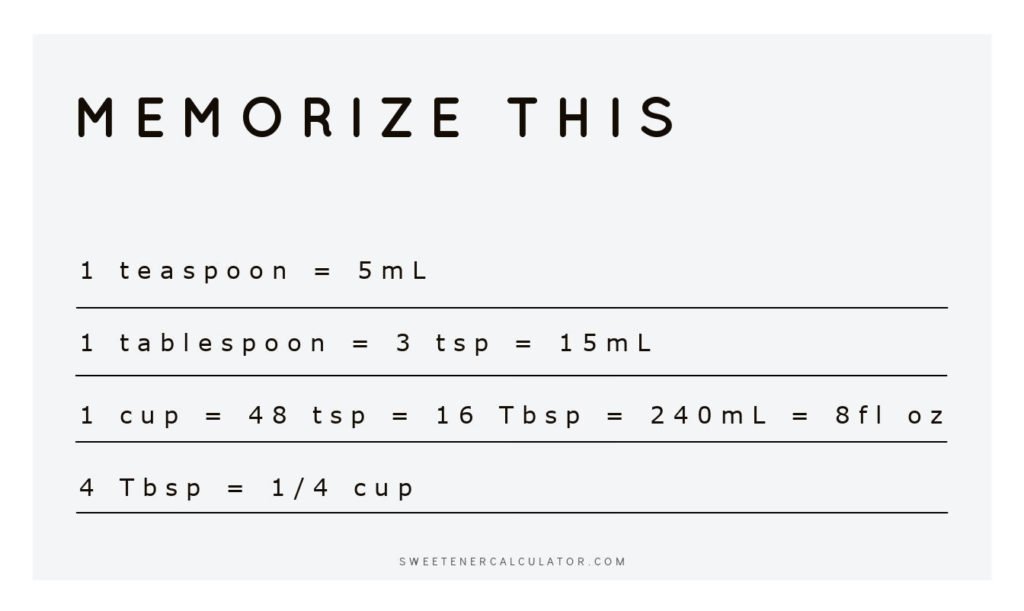
Weighing sweeteners
Weighing sweeteners is faster and easier.
It, of course, involves more accuracy than volume – spoons and cups. It’s essential when baking as 200 g of any sweetener is always the same amount no matter the crystals’ size or the type of measurer you use.
To determine how many ounces, pounds, grams, or kilograms of a sweetener, you’ll need a digital scale such as this one.
If you’re venturing into those super concentrated zero-calories sweeteners (pure stevia, pure monk fruit, pure sucralose, or pure aspartame) consider buying a microscale to weigh in milligrams (mg). Those sweeteners are super sweet, and a little goes a long way. As an example, the image below shows three pure stevia extracts—NuNaturals, SweetLeaf, and BetterStevia. Weighing 22 to 35 mg (1/64 to 1/96 tsp) of them, gives you the same sweetness of 4 g of table sugar (1 tsp).
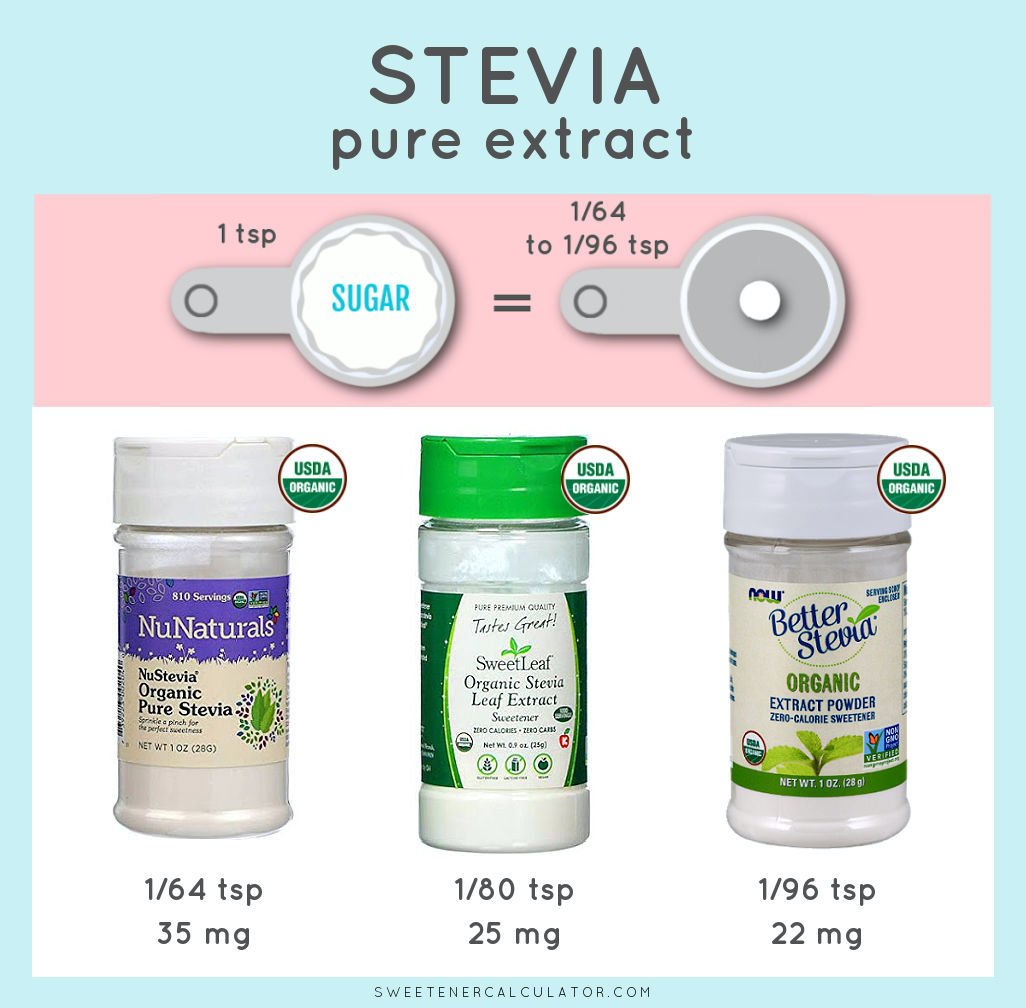
Conclusion
If you want to substitute sweeteners in your coffee, baking or cooking, the Sweetener Calculator will help you out. Convert one sweetener to another — be it liquid (syrups, drops, squeezes) or in dry form (granulated, brown, powdered, crystallized, sticks, packets, cubes, tablets).
From now on, no more getting frustrated with having to do the math yourself every time you swap sweeteners.
Did you find it helpful? If not, let me know how I can improve it.
